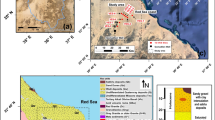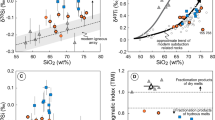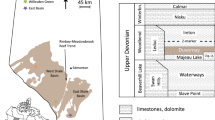Abstract
THE widespread occurrence in central Australia of silcrete which there caps numerous mesas and forms extensive stony pavements on the dissection slopes below them has long awaited a satisfactory explanation. A recent recording1 of the nature and disposition of certain lateritic and desertic soils, taken in conjunction with the location of major drainage divides and the pattern of endoreic streams to the Lake Eyre depression2, throws new light on the problem and indicates the following sequence of pedologic and geomorphic events : (1) A regional development of Lateritic Red Earths occurred across what is now the watershed of eastern and northern Queensland. The lateritic weathering was accompanied by the usual loss of silica in the drainage water, one part going to the Pacific Ocean and the Gulf of Carpentaria and the other to the precursors of the present-day ephemeral and endoreic streams, the Georgina, Diamantina, Barcoo Rivers and Cooper's Creek, the courses of which then extended up to 200 miles further south-west. (2) The silica which moved south-westerly was deposited in a large array of rocks and softer deposits of widely different chronology, including variably weathered sandstones, shales and quartzites, and calcareous, gypseous, saline and alunitic formations. To-day these materials are to be found beneath the silcrete caps of the mesas, and the later group at least indicate aridity and/or restricted drainage at the time of their deposition. (3) The large, gently sloping silcrete surface so formed was disrupted and eroded following the development of the down-warped Lake Eyre basin. This depression and its compensating upwarp to the west and south caused differences in elevation of the order of 1,000 ft. with the lowest point below sea-level. This provided a new, internal, and very low base level for erosion and caused rejuvenation and down-cutting of the streams coming from the north-east and reversal of the drainage in the silcrete area to the west and south of the newly formed depression. The combination of earth movement and erosion caused the break-up of the extensive silicified surface into numerous mesas and associated larger areas of fragmented silcrete represented to-day by the pavement on the Stony Desert Tableland Soils.
This is a preview of subscription content, access via your institution
Access options
Subscribe to this journal
Receive 51 print issues and online access
$199.00 per year
only $3.90 per issue
Buy this article
- Purchase on SpringerLink
- Instant access to full article PDF
Prices may be subject to local taxes which are calculated during checkout
Similar content being viewed by others
References
Stephens, C. G., C.S.I.R.O. Austral., Soil Publ., No. 18 (1961).
David, T. W., and Edgeworth, The Geology of the Commonwealth of Australia (Edward Arnold and Co., London, 1950).
Author information
Authors and Affiliations
Rights and permissions
About this article
Cite this article
STEPHENS, C. Silcretes of Central Australia. Nature 203, 1407 (1964). https://doi.org/10.1038/2031407a0
Issue date:
DOI: https://doi.org/10.1038/2031407a0
This article is cited by
-
Origin of Silcretes of Central Australia
Nature (1966)



